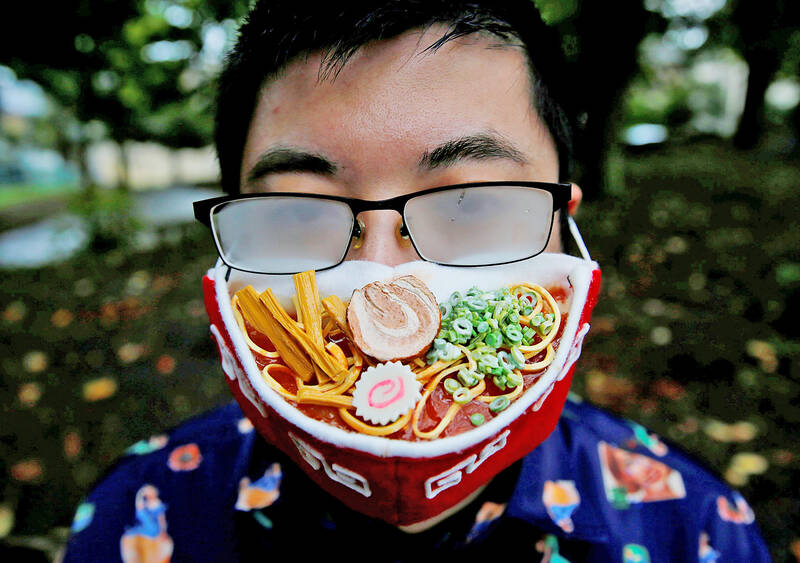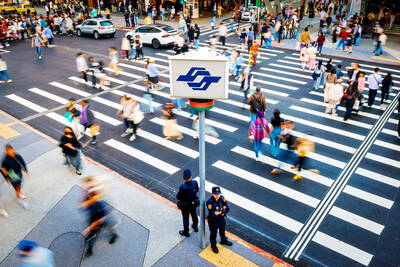For Taiwanese, ramen is one of the dishes that most represents Japan; for Japanese, its origins are in China. Then there is “Taiwan ramen,” which can only be found in Japan, but not in Taiwan.
It is almost impossible to reach a consensus on the origin of any dish, but a brief look at its history might be helpful.
Not many people who are not Japanese question whether ramen is really Japanese.

Photo: Reuters
Yet think about it — ramen is often unctuous and rich, unlike most other must-try Japanese foods familiar to foreign visitors to the country, such as sushi and soba noodles.
According to Kojien, one of the most authoritative Japanese dictionaries, ramen is “soup noodles made in Chinese style.”
It is also called “Shina (支那) noodles or Chinese noodles” — Shina being an archaic Japanese name for China.
The etymology of the term “ramen,” usually written in syllabic hiragana in Japan, is likely the Chinese term “ra men” — written as two Chinese characters meaning “pull” and “noodles” respectively, Japanese food culture academic Okada Tetsu says in his book Ramen’s Birth.
The Nippon Broadcasting System radio network has said that during the Meiji era from 1868 to 1912, Kanichi Ozaki opened a Chinese restaurant called Rairaiken in Yokohama’s Chinatown, providing popular dishes such as Shina noodles made by the Chinese chefs he hired.
Ramen was created in Japan by Chinese chefs and went on to have a unique life journey, Nippon Broadcasting has said.
Tetsu believes that similar noodle dishes were created and sold in many places in Japan during the same period, but the term ramen might have become more widely used during the Taisho era that followed.
What about “Taiwan ramen”?
The “China Taiwan Restaurant Misen” in the central Japanese city of Nagoya, Aichi Prefecture, is generally acknowledged to be where Taiwan ramen originated.
Taiwan-born founder Kuo Ming-yu (郭明優) took inspiration from Taiwan’s danzimian (擔仔麵, “peddler’s noodles”) and gave the dish “a super spicy” makeover, naming it after his birthplace, the restaurant says on its Web site.
Starting as a staff meal, the spicy ramen was added to the menu after gaining approval from regular customers and suddenly became famous during the “super spicy boom” in the late 1980s, it says.
“If the dish was designed for customers from the beginning, I think we would have come up with a cooler name,” third-generation owner Kuoh Sing-chih (郭幸治) said.
Other restaurants in Nagoya wanted to cash in on the ramen so many began selling the popular dish, which regularly appears in rankings of “most-loved Nagoya cuisine” along with miso-flavored deep-fried pork chops and grilled eel rice bowl.
The original restaurant now has three branches in Nagoya, but Kuo Ming-yu’s four brothers and sisters opened independent branches and are said to have developed their own flavors and customer bases.
There are now 16 branches in total, including a few outside Aichi Prefecture in Tokyo and Osaka.
So, what is Taiwan ramen exactly?
Misen puts spicy minced meat, Chinese chives and bean sprouts on top of slightly thick noodles, then adds soup made with chicken bones.
The soul of the dish is, of course, chili pepper, the restaurant says.
The recipe is only faintly reminiscent of Taiwan’s traditional danzimian, which features a shrimp-based soup, shrimp and minced meat that is not spicy.
Tear-inducing spicy minced meat made with lots of garlic and chili is actually rarely seen in Taiwan.
“The spiciness of Taiwanese ramen is unusual. Take a sip of the soup and pause for a few seconds. The strong spiciness will explode in your mouth. If you are not careful, you might choke,” Japanese journalist Nojima Tsuyoshi said.
However, if you are not a fan of spicy food, you can order “Taiwan ramen American,” but if you are looking for a punch of heat, order “Taiwan ramen Italian.” The humble noodle dish really has a globalized naming system.
It is not too difficult to decipher the menu. Think about coffee. As the Americano is a diluted espresso shot, “Taiwan ramen American” is a less spicy version than the regular one, as more soup has been added, while “Taiwan ramen Italian” contains double the amount of chili pepper.
Those who are unable to eat in or have a constant craving for the noodles can order take-home ramen kits and the spicy minced meat, which are sold separately.
Several ramen products labeled as “Nagoya specialty — Taiwan ramen” can also be found in supermarkets as ramen kits and instant ramen in packs or in cups. The name more often than not signals the inclusion of spicy minced meat or, at the very least, the flavor of it.
In 2021, the long-running TV show Himitsu no Kenmin Show (Secret Citizen Show) produced by Japan’s Yomiuri Telecasting Corp aired a special feature on the “Taiwan boom” in Nagoya.
In addition to Taiwan ramen, Taiwan stir-fried noodles, Taiwan rice, Taiwan curry, Taiwan meat skewers, Taiwan cold noodles, Taiwan pasta and Taiwan rice balls have all become part of the fad.
They all include spicy minced meat — enough reason to bear the name Taiwan and become popular.
“People in Nagoya are attracted to anything Taiwan,” which is almost a spontaneous “cell reaction,” a local told the program.
The addition of spicy minced meat is “a guarantee of deliciousness,” regardless of the dish underneath, others said.
Unlike many food trends, the Taiwan boom is not a passing fad as the restaurants the program introduced more than two years ago are still doing well after the COVID-19 pandemic.
Among them is Menya Hanabi, where founder and chef Naoto Niiyama took inspiration from Taiwan ramen and created Taiwan mazesoba, a brothless ramen, and then applied the spicy minced meat magic to curry and opened a new restaurant called Original Taiwan Curry.
Menya Hanabi expanded to the US in 2019 with a new branch in Los Angeles, where the name of the dish was changed to “Nagoya mazesoba.”
If Taiwan ramen was imported to Taiwan, “Nagoya ramen” might be a more suitable name for the dish considering Taiwanese’s love of Japanese food and restaurants.
While purists might disapprove of the misnomer and those who come to Taiwan to track down “authentic” Taiwan ramen might be disappointed, there is never anything wrong with creating delicious food.

SHIPS, TRAINS AND AUTOMOBILES: The ministry has announced changes to varied transportation industries taking effect soon, with a number of effects for passengers Beginning next month, the post office is canceling signature upon delivery and written inquiry services for international registered small packets in accordance with the new policy of the Universal Postal Union, the Ministry of Transportation and Communications said yesterday. The new policy does not apply to packets that are to be delivered to China, the ministry said. Senders of international registered small packets would receive a NT$10 rebate on postage if the packets are sent from Jan. 1 to March 31, it added. The ministry said that three other policies are also scheduled to take effect next month. International cruise ship operators

HORROR STORIES: One victim recounted not realizing they had been stabbed and seeing people bleeding, while another recalled breaking down in tears after fleeing A man on Friday died after he tried to fight the knife-wielding suspect who went on a stabbing spree near two of Taipei’s busiest metro stations, Taipei Mayor Chiang Wan-an (蔣萬安) said. The 57-year-old man, identified by his family name, Yu (余), encountered the suspect at Exit M7 of Taipei Main Station and immediately tried to stop him, but was fatally wounded and later died, Chiang said, calling the incident “heartbreaking.” Yu’s family would receive at least NT$5 million (US$158,584) in compensation through the Taipei Rapid Transit Corp’s (TRTC) insurance coverage, he said after convening an emergency security response meeting yesterday morning. National

PLANNED: The suspect visited the crime scene before the killings, seeking information on how to access the roof, and had extensively researched a 2014 stabbing incident The suspect in a stabbing attack that killed three people and injured 11 in Taipei on Friday had planned the assault and set fires at other locations earlier in the day, law enforcement officials said yesterday. National Police Agency (NPA) Director-General Chang Jung-hsin (張榮興) said the suspect, a 27-year-old man named Chang Wen (張文), began the attacks at 3:40pm, first setting off smoke bombs on a road, damaging cars and motorbikes. Earlier, Chang Wen set fire to a rental room where he was staying on Gongyuan Road in Zhongzheng District (中正), Chang Jung-hsin said. The suspect later threw smoke grenades near two exits

The Forestry and Nature Conservation Agency yesterday launched a gift box to market honey “certified by a Formosan black bear” in appreciation of a beekeeper’s amicable interaction with a honey-thieving bear. Beekeeper Chih Ming-chen (池明鎮) in January inspected his bee farm in Hualien County’s Jhuosi Township (卓溪) and found that more than 20 beehives had been destroyed and many hives were eaten, with bear droppings and paw prints near the destroyed hives, the agency said. Chih returned to the farm to move the remaining beehives away that evening when he encountered a Formosan black bear only 20m away, the agency said. The bear